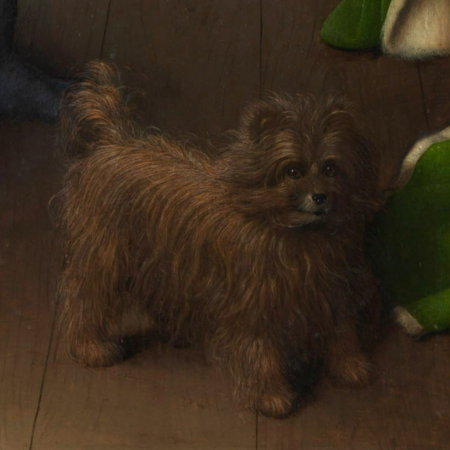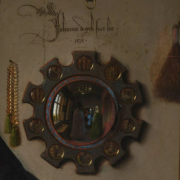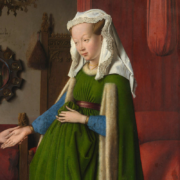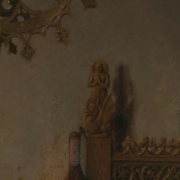The many questions surrounding Jan Van Eyck’s Arnolfini Portrait

Jan van Eyck. Portrait of Giovanni(?) Arnolfini and his Wife. 1434. The National Gallery, London
June is the most popular month to marry, an excellent reason to take a look at one of the world’s most famous wedding paintings–although we ended up wondering if that, indeed, was what we were seeing.
At first glance, Jan Van Eyck’s Arnolfini Portrait (1434) appears to be an exquisitely rendered but otherwise straightforward depiction of a wealthy merchant and his wife. But take a second look (or third or fourth), and a more intriguing image emerges. The room in which the Arnolfinis pose is laden with images that signal wealth, have religious implications, or are just plain… odd.
We don’t know exactly who the couple is in the Arnolfini portrait–they’re commonly thought to be Giovanni de Nicolao Arnolfini and his wife Costanza Trenta–but we do know that they were mostly likely part of the Italian merchant class in Flanders and that they were very, very rich. Like, Kardashian rich. And, frankly, if we want to continue the reality TV comparison, this painting is a carefully curated portrayal to signify wealth–much like the opulence we see depicted in Keeping Up with the Kardashians.
- Jan van Eyck. Portrait of Giovanni(?) Arnolfini and his Wife; Detail. 1434. The National Gallery, London
- Jan van Eyck. Portrait of Giovanni(?) Arnolfini and his Wife; Detail. 1434. The National Gallery, London
- Jan van Eyck. Portrait of Giovanni(?) Arnolfini and his Wife; Detail. 1434. The National Gallery, London
- Jan van Eyck. Portrait of Giovanni(?) Arnolfini and his Wife; Detail. 1434. The National Gallery, London
How do we know this couple was wealthy? The chandelier, stained glass windows, intricately woven rug, sandals, fur-trimmed robes, mirror, dog, and oranges are all signifiers of incredible wealth in 15th century Belgium. Many of these images also do double duty, indicating not only wealth but also conveying allusions to religious and fertility motifs. The chandelier has one lit candle, which represents the seeing eye of God; the mirror is decorated with scenes from the Passion of Christ; and an unblemished mirror is also a symbol of the piety of Mary, Mother of God. There are also rosary beads hanging next to the mirror. Oranges represent fecundity in art, as does the red bed. There is a figure on the finial of St. Margaret, the patron saint of pregnancy and childbirth, while the cherry tree outside the window is a symbol of love.
- Jan van Eyck. Portrait of Giovanni(?) Arnolfini and his Wife; Detail. 1434. The National Gallery, London
- Jan van Eyck. Portrait of Giovanni(?) Arnolfini and his Wife; Detail. 1434. The National Gallery, London
- Jan van Eyck. Portrait of Giovanni(?) Arnolfini and his Wife; Detail. 1434. The National Gallery, London
We’d be remiss if we didn’t address the rather pregnant appearance of Signora Arnolfini. Again, was this an accurate representation of the couple, a hope for the future, another allusion to Mary, or merely a fashionable dress?
And then there are the images that don’t seem to have context. Why is Jan Van Eyck’s signature on the wall above the mirror? Why does it look more like, say, a signature on a piece of paper than a signed piece of artwork? And who are the figures reflected in the mirror? Is one the artist himself? Are they witnesses? And, if so, are they witnessing an actual marriage? Look at how Giovanni is holding his wife’s hand–it looks a bit like when a couple takes each other’s hands while pledging their vows. So maybe Van Eyck’s signature is actually witnessing a marriage signatory… but, if this is what’s being portrayed, how does that line up with who we think is represented in the painting? Giovanni and Costanza were married in 1426; why wait eight years to have a portrait of your marriage depicted? We also know that Costanza died–possibly during childbirth–by 1433. So is the painting just a portrait? A depiction of a marriage? Or a remembrance of a wife who has passed?

Jan van Eyck. Portrait of Giovanni(?) Arnolfini and his Wife; Detail. 1434. The National Gallery, London
The mysteries of the Arnolfini portrait, along with Van Eyck’s masterful technique, continue to enthrall viewers well into its seventh century of existence!
You can see the images from The National Gallery, London–and zoom in for much closer details–by searching for Portrait of Giovanni Arnolfini and his Wife in the Artstor Digital Library.
– Vicki Saxon
You may also be interested in: A closer look at Hans Holbein’s “The Ambassadors”






